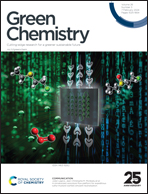Modelling of green biocatalytic (R)-(+)-limonene oxidation using the mycelium of psychrophilic Cladosporium cladosporioides 01†
Abstract
Limonene is a cheap and easily available substrate for obtaining valuable compounds. Limonene epoxides are used as monomers to obtain polymers used in various industries. Development of an environmentally friendly and cheap process of chemoenzymatic epoxidation of limonene is important due to the need to replace petroleum-derived polymers. The lyophilized mycelium of psychrophilic Cladosporium cladosporioides 01 has been found to be an efficient biocatalyst for green chemoenzymatic epoxidation of (R)-(+)-limonene in ethyl acetate. The mathematical optimization of the main process variables with RSM methods is described herein. Modelling of the reaction parameters (temperature, H2O2, biocatalyst, substrate concentration and stirring speed) contributed to an approximately 5-fold increase in the efficiency of epoxidation, compared to that of the non-optimized process. After 4 hours at 55 °C without stirring, 99.8% oxidation of limonene to limonene 1,2-epoxide (56.3%), limonene 8,9-epoxide (0.3%) and diepoxide (43.2%) was achieved using 232.7 μl of H2O2, 88 μl of acetic acid, 284 mg of a biocatalyst and 57.6 μl of limonene. Modelling of epoxidation depending on the limonene : biocatalyst ratio was also performed. The time of achievement of the maximum yield of 1,2-epoxide and limonene diepoxide was determined, which makes it possible to design the process rationally to obtain the desired product. For the first time, the profitability of the green biotechnological method of obtaining limonene epoxides with the use of a new biocatalyst was calculated. Using 2.45 grams of (R)-(+)-limonene, the predicted gain for 20 hours of epoxidation is about 223.5 USD, making this process very advantageous for use on an industrial scale.



 Please wait while we load your content...
Please wait while we load your content...